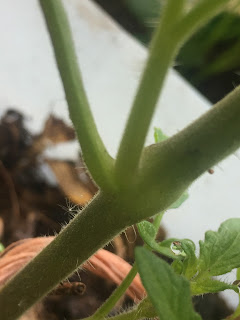Lessons in the garden: The Scientific Method and the problem with the peas!
The days are getting warmer and warmer but things are not as green in some places as they are in others. It seems that some of our crates are not growing as fast in some areas as they are in others. We maintain gardens in a number of spaces and some are thriving while others are not doing quite so well. Time to do some investigating and use the scientific method to figure out what is going on.
The great thing about the crate system is that there is a lot of experimentation that we can do!
A few months ago, when this project began, we drew a lot of our soils from a single source. From there, we added a base of wood chips. This gives us a control group to start from. We have found that some of the various things we have planted have thrived and some have not fared so well. What could be causing this?
Nothing has died, thank goodness. Our initial observation shows that the leaves in one particular garden are yellowing and they are not growing as quickly as at other garden locations. At this point, our students are asked to look at the variables. What is different about this one location as opposed to the others?
Variables...
The sunlight is a little different. This particular area receives a lot more varied sunlight. The kids are noticing that an area that we are growing in now has a diffused sunlight because the surrounding oak trees' leaves have grown in....
The water is different... For our other locations, we almost entirely use rainwater but this particular location has a city water source only 20 feet away.
The landscapers... This particular location is behind a building and the landscapers have been known to use weed killer in the past.
 So, we have to figure out the problem.
So, we have to figure out the problem.
The crates allow us to compartmentalize the problem and study the results!
We thought about how to figure out what is going on. A brief search says that there are lot of things that can be happening. We chose to work with our pea plants because they grow the fastest and to be honest, we were reminded a little of Gregor Mendel...
One of the crates, we added a little compost to.
One of the crates, we added MORE compost to.
One of the crates are slated to get less water.
One of the crates are slated to get more water.
Two of the crates are going to be left as is. These will be our control peas!
While we look very closely at our plants anyway, we will be looking extra closely for the next couple of weeks and figuring out what has been going on with them!
Do you have questions...suggestions?
Feel free to reach out to us at life@thelifecooperative.org!
The great thing about the crate system is that there is a lot of experimentation that we can do!
A few months ago, when this project began, we drew a lot of our soils from a single source. From there, we added a base of wood chips. This gives us a control group to start from. We have found that some of the various things we have planted have thrived and some have not fared so well. What could be causing this?
Nothing has died, thank goodness. Our initial observation shows that the leaves in one particular garden are yellowing and they are not growing as quickly as at other garden locations. At this point, our students are asked to look at the variables. What is different about this one location as opposed to the others?
Variables...
The sunlight is a little different. This particular area receives a lot more varied sunlight. The kids are noticing that an area that we are growing in now has a diffused sunlight because the surrounding oak trees' leaves have grown in....
The water is different... For our other locations, we almost entirely use rainwater but this particular location has a city water source only 20 feet away.
The landscapers... This particular location is behind a building and the landscapers have been known to use weed killer in the past.
 So, we have to figure out the problem.
So, we have to figure out the problem.The crates allow us to compartmentalize the problem and study the results!
We thought about how to figure out what is going on. A brief search says that there are lot of things that can be happening. We chose to work with our pea plants because they grow the fastest and to be honest, we were reminded a little of Gregor Mendel...
One of the crates, we added a little compost to.
One of the crates, we added MORE compost to.
One of the crates are slated to get less water.
One of the crates are slated to get more water.
Two of the crates are going to be left as is. These will be our control peas!
While we look very closely at our plants anyway, we will be looking extra closely for the next couple of weeks and figuring out what has been going on with them!
Do you have questions...suggestions?
Feel free to reach out to us at life@thelifecooperative.org!


Comments
Post a Comment